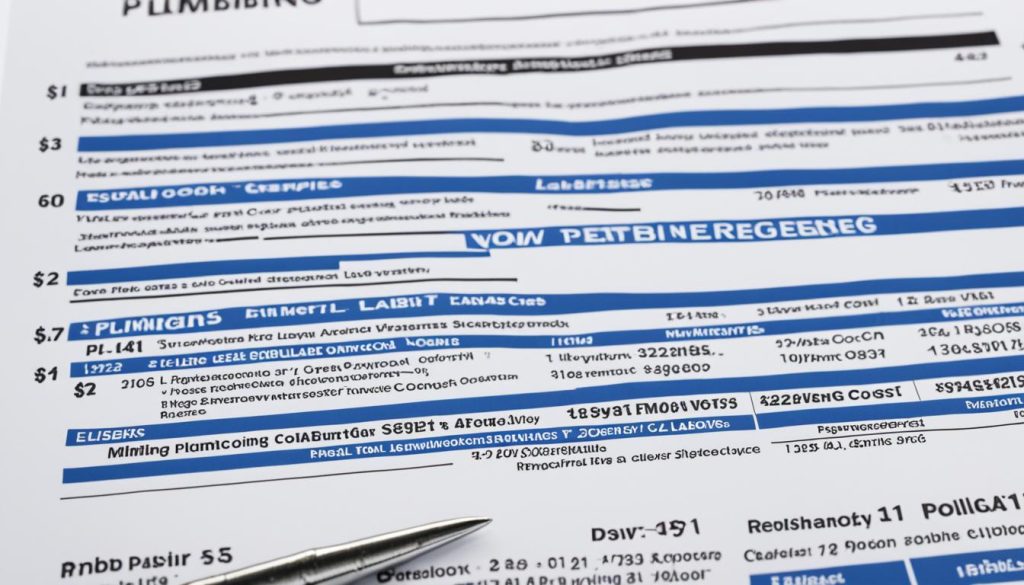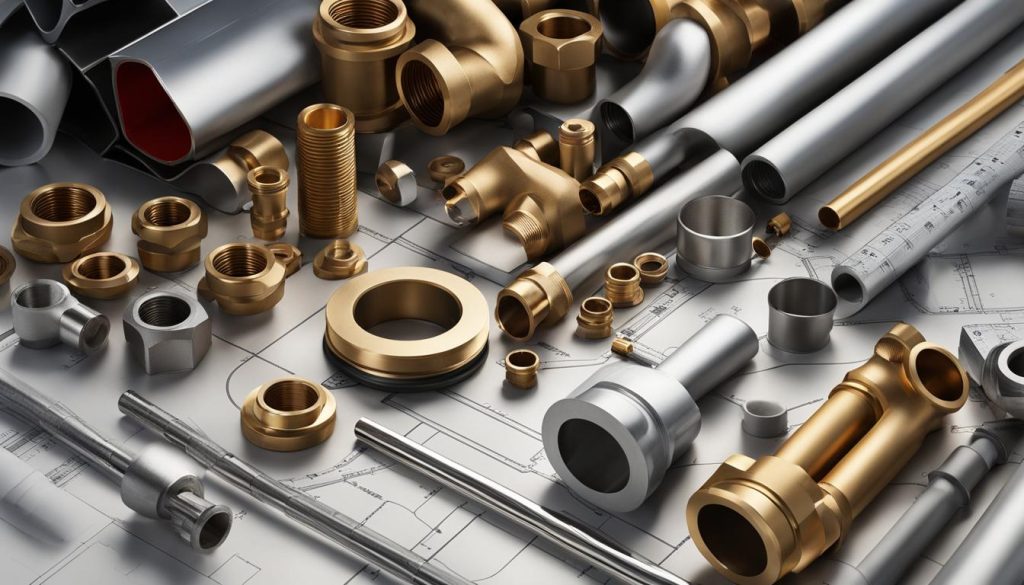New Construction Plumbing Cost Per Sq Ft Guide
Did you know that the average cost of new construction rough-in plumbing is $6,000? Whether you’re building a new home or considering replacing the plumbing in an existing structure, understanding the costs involved is essential for budgeting and planning. Plumbing expenses can vary significantly depending on various factors, such as the size of the project, materials used, and location.
Installing plumbing in a new home typically costs between $1,500 and $17,500, with an average of $6,000 for rough-in plumbing. On the other hand, replacing the plumbing in an existing 2,000-square-foot home can range from $3,000 to $16,000. Labor costs, which can be around $50 to $120 per hour per plumber, make up a significant portion of the final invoice. The cost of materials, including copper, PEX, CPVC, or PVC pipes, also contributes to the overall expense.
Commercial plumbing installation tends to be more expensive, averaging around $6 per square foot, while residential plumbing costs around $4.50 to $5.25 per square foot. Location, pipe material, and the number of bathrooms are additional factors that impact the total cost. It’s essential to have a clear understanding of plumbing costs to ensure you’re prepared for the financial aspect of your new construction project or plumbing replacement.
Key Takeaways:
- The average cost of new construction rough-in plumbing is $6,000.
- Labor costs range from $50 to $120 per hour per plumber for new construction plumbing.
- The cost of plumbing materials varies based on the type of pipes used.
- Commercial plumbing installation is more expensive than residential plumbing.
- Location, pipe material, and the number of bathrooms affect the total cost of new construction plumbing.
Average Cost of New Construction Rough-in Plumbing
When it comes to new construction, understanding the average plumbing cost per square foot is crucial. In this section, we’ll explore the average cost of new construction rough-in plumbing and provide a plumbing cost breakdown to help you plan your budget.
New Construction Plumbing Rates
The average cost of new construction rough-in plumbing is $6,000, with a range of $1,500 to $17,500. This cost includes the installation of supply and drain lines, connecting them to the water and sewer mains. However, it does not include the cost of plumbing fixtures or their installation.
To get a better estimate, many contractors and plumbers use a per-square-foot basis to calculate the plumbing cost for new construction. On average, the cost ranges from $4.50 to $5.25 per square foot for a 2,500-square-foot home.
Plumbing Cost Breakdown
It’s important to note that labor costs for new construction plumbing are typically included in the overall pricing bid, rather than listed as a separate line item. Labor costs can range from $50 to $120 per hour per plumber or $1,500 to $6,000 for the entire project.
In addition to labor costs, the type of materials used in the plumbing system also contributes to the overall cost. Copper, PEX, CPVC, and PVC pipes are common materials, and each has its own price point. The cost of materials will depend on the specific requirements of your project.
Now that we have an understanding of the average cost of new construction rough-in plumbing, let’s explore the cost of replacing plumbing in existing structures, which is covered in the next section.
Cost of Replacing Plumbing in Existing Structures
When it comes to replacing the plumbing in an existing structure, the cost can vary depending on several factors. For a 2,000-square-foot home, the typical cost of replacing plumbing ranges from $3,000 to $16,000. This estimate encompasses labor charges, which can range from $50 to $200 per hour per plumber, as well as the cost of materials.
The hourly labor rates are influenced by the complexity of the project and the geographic location. It’s important to keep in mind that these rates may differ from one area to another. The total cost also includes material expenses, which are determined by the type of pipes chosen for the replacement. The most common pipe options include copper, PEX (cross-linked polyethylene), CPVC (chlorinated polyvinyl chloride), and PVC (polyvinyl chloride).
| Pipe Material | Average Cost per Linear Foot |
|---|---|
| Copper | $3 (supply lines) $8 (drain lines) |
| PEX | $1.15 |
| CPVC | $0.98 |
| PVC | $2 to $4.50 |
In addition to labor and material costs, there are other expenses that may arise during the replacement process. These include obtaining permits, which can range from $50 to $500 depending on the location, and repairing any damage to walls, ceilings, or floors. The cost of repairs generally falls within the range of $40 to $120 per hour.
As plumbing systems in existing structures age, the need for replacement becomes more apparent. Keeping an eye out for signs of plumbing issues is essential. Discolored water, changes in taste, and frequent water pressure drops could indicate corrosion or problems with supply lines. Issues with drains, such as frequent backups or slow drainage, may suggest problems with drain, waste, and vent lines. Any water leaks, regardless of their size, might signify underlying plumbing issues. Lastly, homes with plumbing systems over 50 years old should undergo periodic professional inspections to identify potential problems.
Replacing old plumbing involves the removal of existing pipes, which can range in cost from $1,000 to $4,500 depending on the extent of the project. The cost of installing new pipes, such as PEX or copper, can vary from $1.50 to $12 per linear foot. Additional costs may occur if water mains or drain lines also need to be replaced.
Factors Affecting the Cost of Plumbing Installations
When it comes to plumbing installations, several factors can influence the overall cost. It’s important to consider these factors when estimating expenses and using a plumbing cost estimator or plumbing cost calculator. Understanding what impacts the price will help you budget effectively and avoid any surprises along the way.
Scope of the Project
The size of the home and the extent of the plumbing work required play a significant role in determining the cost. Larger homes will generally require more materials, labor, and time, resulting in a higher overall expense. Additionally, the number of fixtures and rooms that need plumbing installation will contribute to the total cost. Each fixture, such as toilets, sinks, and showers, requires both rough-in and finish plumbing, adding to the complexity and duration of the project.
Accessibility of Existing Pipes
The accessibility of existing pipes can impact the complexity of the installation and, consequently, the cost. If pipes are hidden in crawl spaces or behind walls and floors, additional labor may be needed to access and work on them. This increased labor can drive up the overall expenses, so it’s essential to consider the accessibility when estimating the plumbing cost.
Labor and Material Costs
Labor and material costs can vary depending on market conditions and location. In urban areas, where the cost of living is typically higher, labor rates may be more expensive compared to rural areas. Additionally, the type of pipe material chosen for the installation can also impact the cost. Copper, PEX, CPVC, and PVC pipes are common options, each with its own price point. It’s important to consider the material prices when estimating the overall plumbing cost.
| Factors Affecting Plumbing Installation Cost | Description |
|---|---|
| Scope of the Project | Size of the home, number of fixtures and rooms |
| Accessibility of Existing Pipes | Hidden pipes, additional labor required |
| Labor and Material Costs | Market conditions, location, pipe material prices |
Considering these factors will help you get a more accurate estimate of the average plumbing cost per square foot during your planning process. Remember to consult with professionals and use reliable plumbing cost calculators to ensure you have a clear understanding of the expenses involved.
Signs that Your Plumbing System Needs to be Replaced
As a homeowner, it’s important to know the signs that indicate your plumbing system may need to be replaced. One of these signs is discolored water or changes in taste, which can be a result of corrosion inside the existing pipes. If you notice any unusual color or taste in your water, it’s best to have your plumbing system inspected.
Prolonged or intermittent water pressure drops can also be a cause for concern. These issues may indicate problems with the supply lines, such as obstructions or leaks. If you’re experiencing inconsistent water pressure, it’s a good idea to consult a professional plumber to assess the situation.
Another sign that your plumbing system may need attention is frequent backups in drains or slow-draining sinks and tubs. These issues often point to problems with the drain, waste, and vent lines. They can be caused by clogs, damaged pipes, or improper installation. If you’re dealing with persistent drainage problems, it’s time to consider replacing your plumbing system.
Water leaks, even small ones, should never be ignored. They can indicate underlying plumbing issues and may lead to more significant problems if left unaddressed. If you notice any water leaks in your home, it’s crucial to have them repaired by a professional plumber as soon as possible.
Ultimately, if your home’s plumbing is over 50 years old, it’s wise to schedule periodic professional inspections to identify potential problems. Replacing old plumbing typically involves removing the existing pipes, which can range in cost from $1,000 to $4,500 depending on the extent of the project. The cost of installing new pipes, such as PEX or copper, can vary from $1.50 to $12 per linear foot, with additional costs for replacing water mains or drain lines.
- Investing Wisely: How Windows & Doors in Boost Property Value and Financial Health - April 24, 2025
- The Financial Impact of Personal Injuries: Why Legal Help Matters for Business Owners - April 16, 2025
- The Hidden Financial Costs of Domestic Assault: What Business Owners Need to Know - April 16, 2025













